9
Performance-Based Evaluation and Design
Performance-based design is a process in which the performance of a facility being designed is evaluated over the entire range of possible loadings rather than for one or more discrete ground motion return periods or events. The approach is intended to allow rational decisions regarding appropriate design levels, including decisions related to the added value of increasing the seismic resistance. Financial, construction, and operational issues are considered over the life cycle of the facility. Seismic performance-based evaluation and design usually involves the probabilistic descriptions of ground motions, system response, physical damage, and loss, including casualties, direct economic costs, and indirect economic costs from loss of functionality (see Figure 9.1). Performance-based evaluation and design have emerged within the earthquake engineering community in recent decades as a preferred means to quantify the expected performance of engineered facilities given the uncertain future demands placed on them by earthquakes (NEHRP, 2006; PEER, 2010). Performance-based seismic design methods require that design objectives and performance levels be quantified and that performance be predicted over the full range of possible seismic events. Life cycle impacts and benefits of improved performance can also be evaluated. This approach allows rational trade-offs to be made between the construction costs required to achieve improved performance and the reduced life cycle impacts associated with improved performance (e.g., reduced repair costs).
The application of performance-based engineering and design and probabilistic evaluation of risk and uncertainty has evolved significantly in recent years. These concepts are now central to the management of dams and associated facilities by the U.S. Bureau of Reclamation and the U.S.
Army Corps of Engineers as well as numerous public and private agencies in Canada, Europe, and elsewhere. Hartford and Baecher (2004) present a comprehensive review of the background, theory, and application of performance-based engineering for the safety of dams. The International Navigation Association (2001) guidelines incorporate performance-based design concepts for port structures. The following pages describe the application of these concepts in the specific context of seismically induced liquefaction for generic facilities.

As discussed in previous chapters, liquefaction hazards are generally assessed by evaluating (a) the susceptibility of a soil deposit to liquefaction; (b) the potential for triggering of liquefaction under the anticipated seismic loading; and (c) the consequences of liquefaction triggering. Performance-based evaluation and design provides a means to translate consequences, expressed in traditional engineering terms, into consequences expressed related to losses such as casualties, direct and indirect economic losses, and loss of utility or functionality. Furthermore, performance-based evaluation and design provides a means to consider the entire spectrum of possible seismic events rather than probabilistically or deterministically posed discrete design events.
Consideration of uncertainty is central to performance-based evaluations. In current practice, liquefaction susceptibility, triggering, and consequences usually are deterministically evaluated without explicit consideration of the uncertainty of the various components of the analysis or the quantification of the uncertainty of the performance metric. In performance-based earthquake engineering, explicit consideration of uncertainty is taken into account through probabilistic evaluations of liquefaction susceptibility, triggering, and consequences combined with a probabilistic evaluation of the ground motion hazard to produce estimates of liquefaction risks that are rational and consistent. This type of approach was used to great effect in the design of liquefaction mitigation measures for the TONEN tank farm complex in Tokyo, Japan, in the 1980s (see Box 9.1).
This chapter outlines the general approaches to performance-based evaluation and design and presents recent application of the approaches. Appendix D provides details regarding the implementation of performance-based design within the required probabilistic framework.
APPROACHES TO PERFORMANCE-BASED EVALUATION
The performance-based approach can be used in many ways, most simply by implementing them at the response level. Measures of system response (e.g., settlement, lateral spreading displacement values) may be specified at various hazard levels or return periods. From the response values, physical damage and loss are then inferred, often guided by judgement and experience. A large uncertainty may be associated with loss estimates derived in this way. An intermediate approach specifies performance related to damage limit states, which involves comparison of the predicted and allowable responses (i.e., limit state). This approach involves prediction of damage (e.g., minor cracking, number of pipe breaks per km) considering
uncertainties associated with the response and damage models. Loss is inferred from damage in this approach, but there is less uncertainty in inferring loss from specific damage levels than from specific response levels. The most complete approach defines performance in terms of losses, including both loss of life and monetary loss; it involves the explicit modeling of response, damage, and loss accounting for the uncertainties inherent in each. While requiring more effort, loss level implementation provides the most accurate and least uncertain estimate of loss (Kramer, 2014).
Response-Level Implementation
In practice, performance-based evaluations are usually implemented at the response level. For liquefaction problems, this typically involves evaluation of the potential for triggering followed by evaluation of the anticipated ground movements using a response model. To be employed in the performance-based framework, both analyses must be performed using probabilistic techniques. The probabilistic approaches described below illustrate the importance of considering all levels of shaking that can lead to triggering and consequences of liquefaction as well as considering the uncertainty in the predictions. These approaches allow development of a response hazard curve that indicates how often, on average, different levels of response can be expected. For example, a response hazard curve may provide the level of displacement that has a 2,475-year return period. Response hazard curves account for local seismicity (e.g., including all expected earthquake magnitudes at all potential source-to-site distances); uncertainty in ground motions given those magnitude and distance combinations; and uncertainties in prediction of liquefaction triggering and movement of soils as a consequence of liquefaction movements (e.g., settlement, lateral spreading).
The level of response that has a 2,475-year return period will be different from the response computed deterministically based on a 2,475-year ground motion. Basing design criteria on a particular return period for liquefaction (Kramer and Mayfield, 2005; Kramer et al., 2006; Franke et al., 2014) or on particular return periods of settlement or lateral spreading displacement provides more uniform performance across different seismic environments than the current practice of basing evaluations on deterministic factors of safety (FS) computed for a single ground motion hazard level.
Fully probabilistic procedures for evaluating liquefaction triggering have been developed (Marrone et al., 2003; Kramer and Mayfield, 2005, 2007; Juang et al., 2008; Baker and Faber, 2008; Mayfield et al., 2010; Franke et al., 2014). Kramer and Mayfield (2007) described a probabilistic liquefaction hazard analysis procedure for evaluating liquefaction triggering that generates FS hazard curves (see Figure 9.2) that account for all peak ground acceleration (PGA) levels and all magnitudes that contribute to those PGA levels. These curves show the mean annual rate of non-exceedance for different values of FS against triggering, ΛFSL. The reciprocal of the value of ΛFSL for FSL = 1.0 is the return period of liquefaction (i.e., the average length of time between occurrences of liquefaction of that element of soil). The hazard curves in Figure 9.2 were calculated for a hypothetical site profile placed in five cities with different seismic hazards. The mean annual rates of non-exceedance are higher for the more seismically active areas (e.g., California versus Tennessee), but not by a constant factor because the curves reflect the differences in ground motion recurrence and the underlying magnitude contributions in different areas. Kramer and Mayfield (2007) showed that application of conventional, deterministic liquefaction hazard evaluation procedures used in practice (i.e., achieving a minimum FS based on ground shaking from a single return period) produced very different liquefaction hazards at the different sites, with the return period of liquefaction varying by a factor of two or more. This result demonstrates that current deterministic procedures do not provide similar levels of safety against liquefaction at sites in different seismic environments, as quantified by the liquefaction hazard, and justifies movement toward the probabilistic approach.
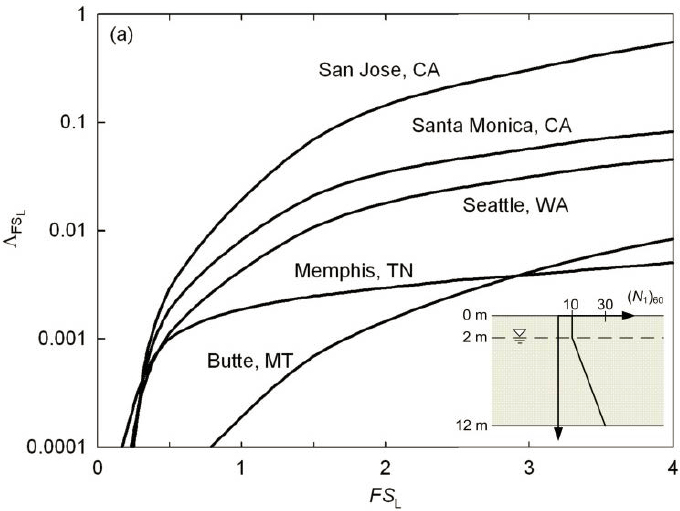
The calculation of a liquefaction FS hazard curve requires a cyclic resistance ratio curve with an assigned probability of liquefaction. As noted in Chapter 4, the meaning of the probabilities associated with various liquefaction curves in the published literature may be ambiguous. In their original form, the curves may represent the probability of the observed data given that liquefaction occurs rather than the probability of liquefaction given the observed data. Therefore, users of probabilistic liquefaction curves should be sure that they understand the basis for the curves they employ and that they are appropriate for the situation at hand (see Chapter 4, Box 4.2).
Kramer and Huang (2010) used a response-level performance-based design framework with a probabilistic settlement model (Huang, 2008) to compute hazard curves for post-liquefaction (free-field) settlement. Figure 9.3 shows settlement hazard curves for a hypothetical site in Seattle, Washington. Empirical lateral spreading models can be used to compute lateral spreading displacement hazard curves in a slightly different manner. Franke and Kramer (2014) developed a probabilistic version of the lateral spreading relationship developed by Youd and colleagues (2002) and used it to compute displacement hazard curves for a generic site assumed to be located in 10 U.S. cities with very different seismic environments (see Figure 9.4). Although each site was predicted to move approximately 30 cm under the loading associated with the 475-year ground motion using the deterministic displacement prediction procedure developed by Youd and colleagues (2002), the computed return periods from the fully probabilistic analyses of these sites showed that the actual return periods for 30 cm of displacement ranged from 77 to more than 2,300 years.
A conventional deterministic analysis, which ignores uncertainty in the displacement prediction, implicitly assumes the return period of the response is the same as the return period of the design ground motion (475 years in this case). When accounting for uncertainty in the response through a fully probabilistic analysis, however, the return period for the response is not equal to the return period of the ground motion. Given that there is uncertainty in the response prediction, the probabilistic analysis provides the more accurate assessment of the response return period.
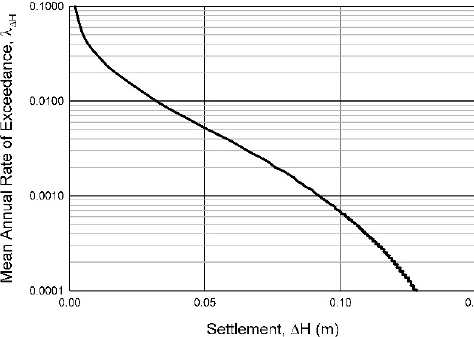
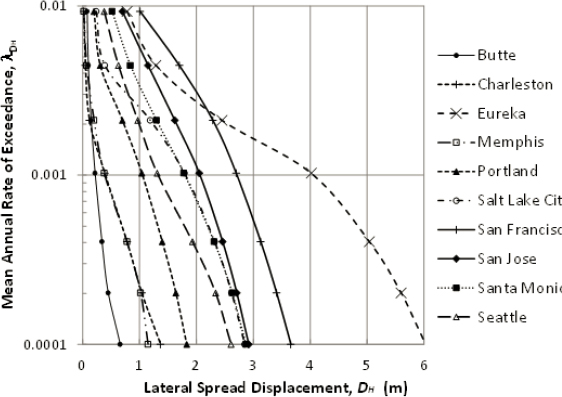
Damage-Level Implementation
A damage-level implementation of performance-based design considers the ground motion hazard curve, a response model, and a damage model. The damage model is commonly displayed through fragility curves, which predicts the probability of a damage state (e.g., minor cracking) being exceeded given a response level (e.g., displacement). Attempts to explicitly predict damage in the structural engineering discipline are more advanced than within geotechnical engineering. Structural engineers often refer to maximum allowable damage as a damage limit state.
Bird and colleagues (2005) performed structural analyses to evaluate damage to reinforced concrete frame buildings from differential ground movements and developed fragility curves for damage limit states while considering uncertainties in input parameters. To isolate the effects of liquefaction, they used damage models to compare damage scenarios with and without ground-failure-induced damage at a liquefiable site, and they noted the need for improved characterization of the relationships between ground movement and structural damage.
Ledezma and Bray (2010) analyzed the potential damage to a five-span bridge supported by piles that extended through liquefiable soils susceptible to lateral spreading. The response models accounted for uncertainty in liquefaction triggering, uncertainty in the residual strength of the liquefiable soil, and uncertainty in the lateral displacement prediction. They defined five discrete damage states (none, small, moderate, large, and collapse) based on predicted displacement. For a site located in Oakland, California, the computed probabilities of reaching the five damage states are shown for two specific ground motion levels in Figure 9.6. Because only two ground motion levels were considered, this approach is not considered fully probabilistic, but the analysis shows that for a given ground motion level a range of damage states is possible because of uncertainties in the response prediction and damage prediction.
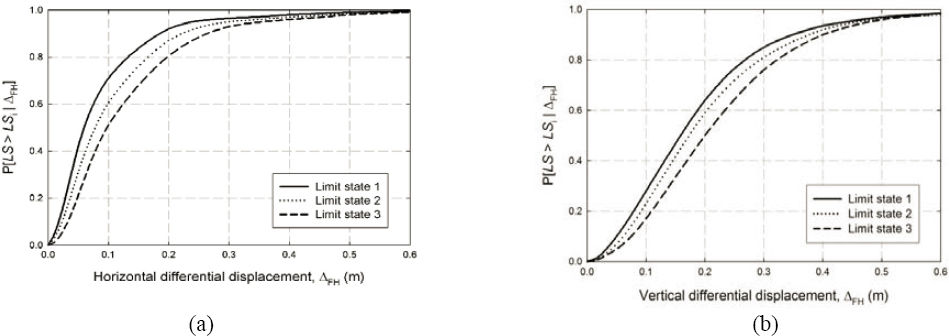
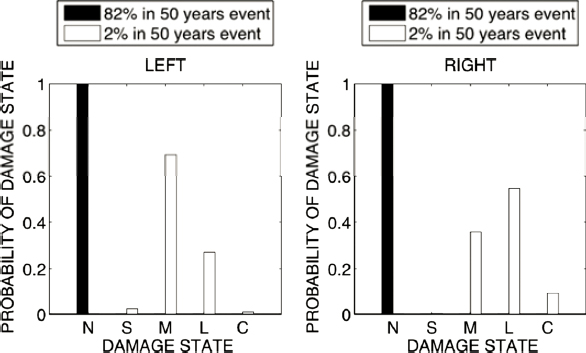
Loss-Level Implementation
The most complete performance-based design procedure specifies performance in terms of expected losses. Although such evaluations represent the most advanced application of performance-based design, they are, for now, only practical for particularly large or particularly important projects due to the significant work required to perform the analyses. Nevertheless, they represent the future of earthquake engineering practice (Kramer, 2014).
Iai and colleagues (2008) described the design of a caisson quay wall in approximately 15 meters of water resting on liquefiable foundation soils and with liquefiable backfill. They considered five options to improve the foundation soil and the backfill soil behind the quay wall and developed fragility curves for damage state based on a series of parametric finite element response analyses. Lifecycle costs for each of the five options were calculated based on a repair cost of 1 million yen/m (approximately $3,000/ft) of wall length (see Figure 9.7). Construction costs were similar for all the options, so the predicted direct losses differed only slightly. However, Option B in Figure 9.7 turned out to be the clear choice for minimizing costs because its indirect losses (i.e., those associated with loss of functionality) were lower.
Kramer and colleagues (2009) analyzed the same bridge considered by Ledezma and Bray (2010). Using finite element analyses to predict response, the computed loss curves expressed as the ratio of repair cost to replacement cost, termed the repair cost ratio, or RCR (see Figure 9.8a). The losses were deaggregated to show the contributions of the various repair methods to the predicted loss at a particular return period (see Figure 9.8b). Such deaggregations can provide an engineer and owner with a useful indication of the origin of the losses.
Bradley and colleagues (2010) described a loss-level evaluation of a pile-supported bridge underlain by liquefiable soil in New Zealand. Finite element analyses of the soil-foundation-bridge system were used to predict system response related to nine response parameters, including peak pile curvature, maximum abutment seating displacement, and approach embankment settlement. Discrete damage states (e.g., cracking, yielding, and failure of piles) were defined for each of the response parameters, and repair costs and repair durations were defined, with uncertainties, for each of the discrete damage states. Figure 9.9 shows loss curves for both the direct repair costs and the indirect costs associated with loss of functionality, and these curves show that the costs associated with loss of functionality are far greater than are the direct costs of the repairs themselves. Foundation compaction was accomplished by sand compaction piles at indicated spacings.
FUTURE DEVELOPMENTS FOR PERFORMANCE-BASED EVALUATIONS
The calculations required for probabilistic performance evaluations may not be complicated, but they are almost always voluminous. A full loss-level implementation requires integration over all ground motion levels, response levels, and damage levels. For a given structure, detailed loss analyses will recognize the existence of multiple foundation-structure components within a structure; therefore, multiple response parameters and damage measures need to be computed. In these cases, the between-component correlations must be determined and taken into account while
integrating over all components. Even the loss estimate may involve multiple parameters if multiple components of loss (e.g., repair costs and loss of functionality) are considered. Because fully probabilistic performance-based evaluations have been developed only recently, computer programs and tools for their convenient and efficient use are in relatively early stages of development. Programs that perform response-level implementations are currently available (see, e.g., Huang, 2008; Franke et al., 2014), and programs for full loss-level implementations are in development (see, e.g., Bradley, 2009; Silva et al., 2014). Additional development of these programs and tools is needed for performance-based evaluation and design to be adopted widely in engineering practice.
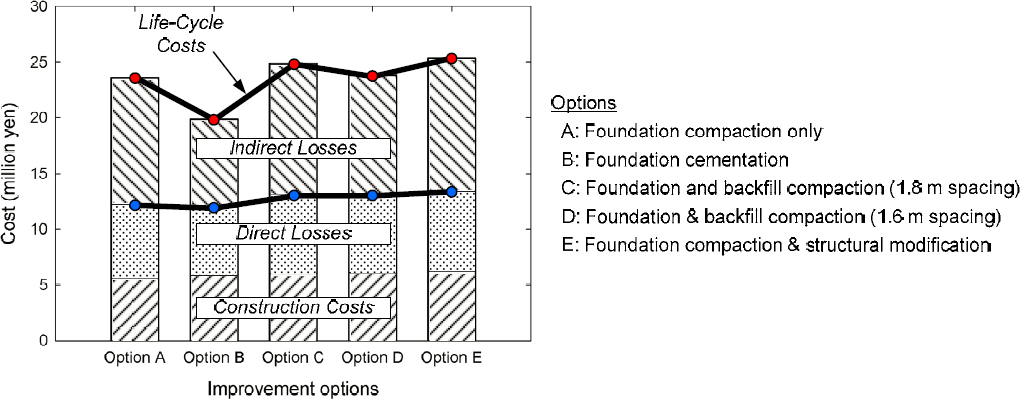
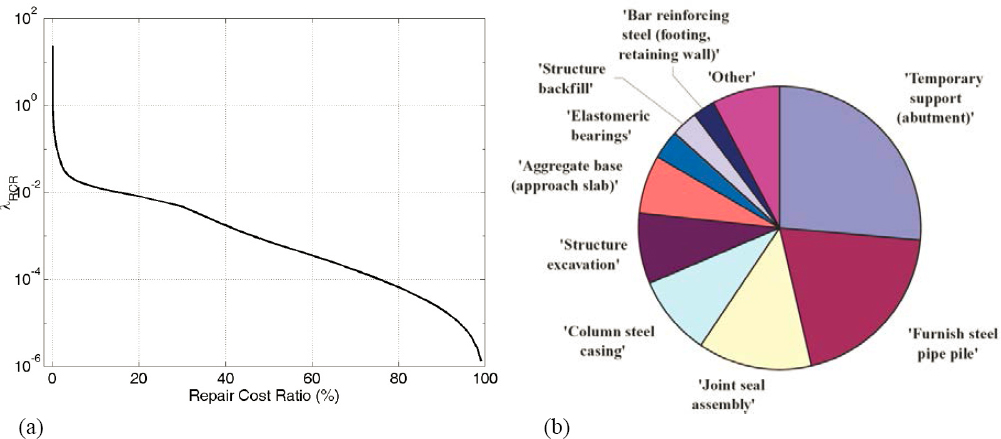
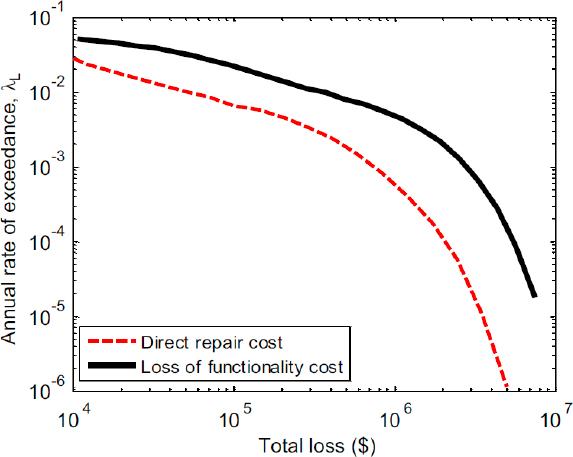
Fully probabilistic procedures show that uncertainties, whether in prediction of liquefaction triggering or of consequences, significantly influence the calculated liquefaction hazards. Improved response models are required that better quantify uncertainty and allow better understanding of how much uncertainty can be reduced through such measures as increased subsurface exploration, increased field and laboratory testing, more sophisticated analyses, additional research, or other means. The ability to demonstrate the cost-effectiveness of such measures is a major benefit of probabilistic performance-based liquefaction hazard evaluations.
Performance has several components, including physical damage, casualties, direct and indirect costs, and loss of functionality, and it is viewed differently by different stakeholders. Advances in performance-based procedures for liquefaction problems will require improved understanding of the damage to different types of structures and facilities caused by different levels of liquefaction-related ground deformation as well as improved understanding of the costs and time requirements of repairing damage associated with liquefaction.
Data available today, in some cases, may not be adequate to quantify uncertainty and bias. In such cases, subjective assessments may be necessary for some parameters. As performance-based design becomes more widely used in geotechnical earthquake engineering, additional data and experience will lead to more accurate quantification of uncertainties and less subjective estimates of the probabilities of different levels of performance.
Performance-based approaches offer great opportunities to produce more reliable structures and facilities and to use available resources more efficiently. Adoption of performance-based engineering concepts into practice, however, will occur as engineers continue to refine their thinking about uncertainty and risk. A fundamental shift from dependence on empirical conventions and designs based on factors of safety toward design processes based on realistic risk-based predictions of the response of engineered systems. This is a more scientifically oriented approach that emphasizes accurate site characterization and performance prediction as well as explicit consideration and quantification of uncertainties.










